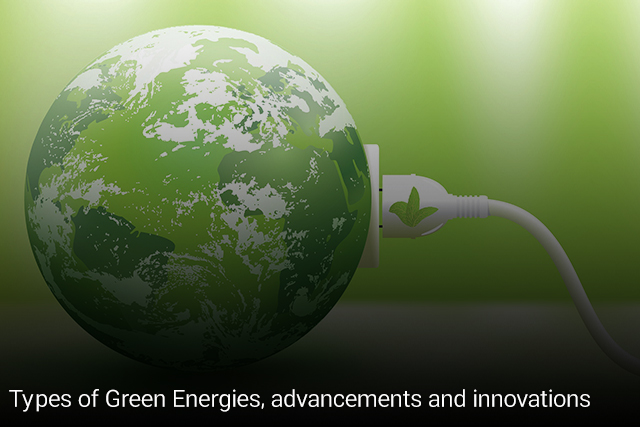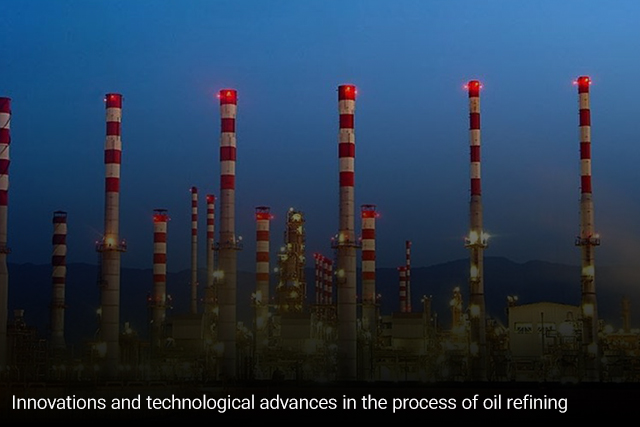Man-kind Looking for Salvation
It is literally impossible for you to be living in twenty-first century, through post-modernism and all its possible challenges, and be impartial to different natural and human-caused crises threatening THE EARTH! It is essential for people, scientists and governments to be concerned about finding better ways to produce energy. A way that would help us the most, hurting the environment the least….
In this article, there will be a brief look over different types of green energies, elaborating on their advancements and new innovations.
Green Energies
Green energies refer to the various forms of power-generation that have a minimal environmental impact compared to traditional fossil fuels. These renewable energy sources are vital in addressing climate change, reducing greenhouse gas emissions, and decreasing dependence on finite resources. Here are the main types:
Solar Power
Solar power represents a cornerstone in the transition towards more sustainable and renewable energy sources. By converting sunlight into electricity, either through photovoltaic (PV) cells or concentrating solar power (CSP) systems, it offers a clean, inexhaustible, and increasingly affordable energy solution. The technology behind solar power is adaptable, capable of being implemented in various scales from small residential setups to vast utility-scale solar farms. This versatility, combined with significant advancements in efficiency and storage solutions, has propelled solar energy to the forefront of green energy alternatives. Its environmental benefits are substantial, reducing the reliance on fossil fuels and contributing to a significant decrease in greenhouse gas emissions.

However, the adoption of solar power is not without challenges. Initial installation costs, though decreasing, still represent a significant investment for many. Moreover, solar energy production is inherently variable, dependent on factors such as weather conditions and time of day. Despite these obstacles, the trajectory of solar power is overwhelmingly positive. Government incentives, technological advancements, and increasing public demand for sustainable energy options are driving rapid growth in the solar sector. As storage technologies improve and costs continue to fall, solar power is set to play an integral role in achieving global energy sustainability goals, making it a critical component of the world’s energy future.
Wind Energy
Wind energy is a clean, renewable source of power generated by converting the kinetic energy of wind into electrical energy. This transformation is achieved through the use of wind turbines, which are tall structures equipped with blades that rotate as the wind blows. The rotation of these blades turns a rotor connected to a generator, which then produces electricity. Wind energy is considered one of the most sustainable forms of energy available, as it does not emit harmful pollutants or greenhouse gases during the generation process, contributing significantly to the reduction of global carbon footprints. Furthermore, the wind itself is an inexhaustible resource, making wind energy a reliable and abundant source of power that can help meet the world’s increasing energy demands.

Wind turbines can be installed in various environments, including onshore (land-based) and offshore (sea-based) locations, each offering distinct advantages. Onshore wind farms are typically easier and cheaper to construct and maintain, while offshore wind farms can capture stronger and more consistent winds, potentially generating more electricity. The design and technology behind wind turbines have evolved significantly, leading to more efficient and powerful turbines capable of generating substantial amounts of electricity even from less windy conditions. This evolution underscores the potential of wind energy as a key component in the transition towards a more sustainable and cleaner energy future. As countries around the world strive to decrease their reliance on fossil fuels, wind energy stands out as a viable and promising alternative to power the future.
Geothermal Energy
Geothermal energy is a form of renewable energy harnessed from the heat emitted by the Earth’s core. This natural thermal energy is generated by the radioactive decay of minerals and the original heat from the planet’s formation. Unlike other renewable sources that depend on the sun or wind, geothermal energy offers a constant and reliable energy supply, available 24 hours a day, throughout the year. It’s tapped through various methods, including geothermal power plants which convert this heat into electricity, and direct use applications which utilize the heat directly for heating buildings, agricultural uses, and other processes. Geothermal power plants primarily operate by circulating water or another working fluid through underground reservoirs, capturing the Earth’s heat, which is then used to turn turbines and generate electricity. This process emits significantly fewer greenhouse gases compared to fossil fuels, making geothermal energy an environmentally friendly option that contributes to global efforts to reduce carbon emissions and combat climate change.

The potential of geothermal energy is vast and globally distributed, with significant resources found across different continents, from the United States and Iceland to Indonesia and New Zealand. These geothermal hotspots are often located near tectonic plate boundaries where volcanic activity brings the Earth’s heat closer to the surface. Advances in technology and drilling techniques are expanding the viability of geothermal energy beyond these hotspots, allowing for the exploration of Enhanced Geothermal Systems (EGS) which can harness heat from deeper and more widespread geothermal resources. This expansion could significantly increase the global capacity for geothermal energy, offering a sustainable, reliable, and potent source of clean energy. The development and scaling of geothermal energy technologies promise to play a critical role in transitioning to a renewable energy-dominant future, reducing dependency on fossil fuels, and achieving global energy security and environmental goals.
Biomass Energy
Biomass energy is a form of renewable energy derived from organic materials, such as plant matter and animal waste, which are used to produce electricity, heat, and biofuels. This type of energy harnesses the natural process of photosynthesis by which plants absorb carbon dioxide and sunlight to create oxygen and biomass. When biomass is burned or biochemically converted into energy, it releases the energy stored from the sun, making it a sustainable loop of energy production. Biomass is considered a renewable resource because its supply is abundant and can be replenished relatively quickly. It plays a crucial role in reducing reliance on fossil fuels by providing an alternative energy source that can be used for electricity generation, heating, and in the production of biofuels for transportation. The use of biomass for energy production also offers the advantage of reducing waste in landfills, as it utilizes organic materials that would otherwise decompose and release methane, a potent greenhouse gas.

However, the sustainability of biomass energy is contingent upon careful management and the balance between production and consumption. The cultivation of crops for bioenergy should not compromise food security or lead to deforestation, which can negate the carbon savings from using biomass. Advanced technologies, such as anaerobic digestion (to produce biogas from agricultural waste) and the development of second-generation biofuels (which use non-food biomass), are crucial for enhancing the efficiency and sustainability of biomass energy. These technologies aim to minimize environmental impacts while maximizing energy output, contributing to a more sustainable and cleaner energy future. Despite these challenges, biomass energy remains an integral part of the global energy mix, offering a versatile and scalable option to meet the world’s growing energy demands while supporting rural economies and reducing greenhouse gas emissions.
Progressive Countries on the Matter of Green Energies
Iceland stands out as the country with the most renewable energy in the world, with 86.87% of its energy coming from renewable sources. Also, China has more than 80 percent of the world’s solar manufacturing capacity. The extraordinary scale of China’s renewables sector output has driven down prices worldwide, and this is a key factor in reducing the cost barrier to renewable systems for poorer countries. Sweden relied on renewable energy, including hydropower, wind, biofuels and heat pumps, to deliver nearly two-thirds of its energy consumption in 2022.
Thank you for your time!



